|
|
| TurningStone Home Inspection, LLC | Homebuyer |
|
|
|
Date: 12/22/2007 |
Start Time: 12:00 PM End Time: 04:36 PM |
Report ID: ExampleReport |
|
Property: 321 Any Street Peachtree City, GA 30269 |
Customer: Mr. Joe Homebuyer |
Real Estate Professional: |
Comment Key or Definitions
The following definitions of comment descriptions represent this inspection report. All comments by the inspector should be considered before purchasing this home. Any recommendations by the inspector to repair or replace suggests a second opinion or further inspection by a qualified contractor. All costs associated with further inspection fees and repair or replacement of item, component or unit should be considered before you purchase the property.
Inspected (IN) = I visually observed the item, component or unit and if no other comments were made then it appeared to be functioning as intended allowing for normal wear and tear.
Not Inspected (NI)= I did not inspect this item, component or unit and made no representations of whether or not it was functioning as intended and will state a reason for not inspecting.
Not Present (NP) = This item, component or unit is not in this home or building.
Repair or Replace (RR) = The item, component or unit is not functioning as intended, or needs further inspection by a qualified contractor. Items, components or units that can be repaired to satisfactory condition may not need replacement.
In Attendance: Customer and their agent | Type of building: Single Family (2 story) | Approximate age of building: 17 Years |
Temperature: 50 degrees F | Weather: Cloudy | Ground/Soil surface condition: Damp |
Rain in last 3 days: Yes | Radon Test: No | Water Test: No |
| Styles & Materials Roof Covering: 3-Tab fiberglass Viewed roof covering from: Ground Binoculars Chimney (exterior):
Brick Metal Flue Pipe |
||||||||||||||||||||||||||||||||||||
 1.0 (1) The roof covering is old, and the life of covering has expired. The covering does need to be
replaced. While it could last a year or so, some areas may need patching with tar as leaks
develop.
1.0 (1) The roof covering is old, and the life of covering has expired. The covering does need to be
replaced. While it could last a year or so, some areas may need patching with tar as leaks
develop. |  |
 (2) Front of Home - Roof missing single/shingle torn and nail fasteners exposed, nail pops pushing
up on shingles. Recommend roofing contractor to thoroughly inspect roof for other potential
problem areas and repair and replace as necessary.
(2) Front of Home - Roof missing single/shingle torn and nail fasteners exposed, nail pops pushing
up on shingles. Recommend roofing contractor to thoroughly inspect roof for other potential
problem areas and repair and replace as necessary.
 |
 (3) Front of Home - Roof ridge cap torn and missing, susceptible to water intrusion behind fascia
boards and potential rot. Recommend roofing contractor to thoroughly inspect roof for other
potential problem areas and repair and replace as necessary.
(3) Front of Home - Roof ridge cap torn and missing, susceptible to water intrusion behind fascia
boards and potential rot. Recommend roofing contractor to thoroughly inspect roof for other
potential problem areas and repair and replace as necessary.
 |  |
 (4) Left Side of Home - Roof ridge cap torn and missing, susceptible to water intrusion behind
fascia boards and potential rot. Recommend roofing contractor to thoroughly inspect roof for
other potential problem areas and repair and replace as necessary.
(4) Left Side of Home - Roof ridge cap torn and missing, susceptible to water intrusion behind
fascia boards and potential rot. Recommend roofing contractor to thoroughly inspect roof for
other potential problem areas and repair and replace as necessary.
 |
 (5) The Roof shingles is lifting/buckling at the chimney. Unable to determine if this area will leak,
recommend a roofing contractor, inspect this area any any other areas of concern and repair
and replace as necessary.
(5) The Roof shingles is lifting/buckling at the chimney. Unable to determine if this area will leak,
recommend a roofing contractor, inspect this area any any other areas of concern and repair
and replace as necessary.
 |
 (6) Front of Home - Satellite dish attached directly to roof decking susceptible to leaks.
Recommend roofing contractor to thoroughly inspect roof for other potential problem areas and
repair and replace as necessary.
(6) Front of Home - Satellite dish attached directly to roof decking susceptible to leaks.
Recommend roofing contractor to thoroughly inspect roof for other potential problem areas and
repair and replace as necessary.
 |
 (7) The Roof shingles is damaged at the edges of "entire roof" in various places. This damage
should be repaired or replaced to prevent water intrusion and potential rot behind fascia
boards and into roof decking. Recommend roofing contractor to thoroughly inspect roof for
other potential problem areas and repair and replace as necessary.
(7) The Roof shingles is damaged at the edges of "entire roof" in various places. This damage
should be repaired or replaced to prevent water intrusion and potential rot behind fascia
boards and into roof decking. Recommend roofing contractor to thoroughly inspect roof for
other potential problem areas and repair and replace as necessary.
 |
 1.3 (1) In general the gutters appear intact, with the exceptions noted, but due to the lack of recent
rain, I am unable to determine if gutters leak at seams or spills water. Some gutters coming
loose from house, gutter spikes pulling away. Recommend qualified repairman inspect and
re-fasten loose gutters.
1.3 (1) In general the gutters appear intact, with the exceptions noted, but due to the lack of recent
rain, I am unable to determine if gutters leak at seams or spills water. Some gutters coming
loose from house, gutter spikes pulling away. Recommend qualified repairman inspect and
re-fasten loose gutters. (2) The gutters are full of debris in areas and needs to be cleaned. The debris in gutters can also
conceal rust, deterioration or leaks that are not visible until cleaned, and I am unable to
determine if such conditions exist.
(2) The gutters are full of debris in areas and needs to be cleaned. The debris in gutters can also
conceal rust, deterioration or leaks that are not visible until cleaned, and I am unable to
determine if such conditions exist. (3) The gutter is missing at the front left corner of home. Erosion can continue or become worse if
not corrected. A qualified person should repair or replace as needed.
(3) The gutter is missing at the front left corner of home. Erosion can continue or become worse if
not corrected. A qualified person should repair or replace as needed. |
 (4) The downspout needs reconnecting to existing drain line at the front (right of main entry).
Gutters that drain poorly or clogged can lead to many costly problems such as deterioration
of fascia, soffit or roof edge. It can also cause gutters to pull loose and lead to possible
water intrusion Loose or leaking gutters can cause deterioration of fascia, soffit or roof edge.
It can also cause gutters to pull loose and lead to possible water intrusion. A qualified
person should repair or replace as needed.
(4) The downspout needs reconnecting to existing drain line at the front (right of main entry).
Gutters that drain poorly or clogged can lead to many costly problems such as deterioration
of fascia, soffit or roof edge. It can also cause gutters to pull loose and lead to possible
water intrusion Loose or leaking gutters can cause deterioration of fascia, soffit or roof edge.
It can also cause gutters to pull loose and lead to possible water intrusion. A qualified
person should repair or replace as needed. |
 (5) The downspouts splash-blocks at all gutter downspouts are reversed. This can lead to water
draining back into foundation and possible water intrusion and foundation erosion. A qualified
person should repair or replace as needed.
(5) The downspouts splash-blocks at all gutter downspouts are reversed. This can lead to water
draining back into foundation and possible water intrusion and foundation erosion. A qualified
person should repair or replace as needed. | 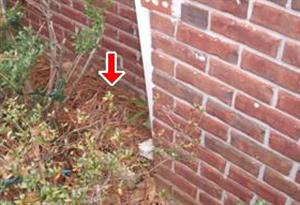 |
| Styles & Materials Siding Style: Lap Brick Siding Material: Vinyl Full brick Exterior Entry Doors: Steel Appurtenance: Covered porch Porch Sidewalk Driveway:
Concrete |
||||||||||||||||||||||||||||||||||||||||||||||||
 2.0 (1) Gap between siding and brick along chimney. Can lead to water infiltration behind brick and
siding leading to water damage and rot to underlying framing. Can also lead to pest infestation.
Recommend repairman to inspect and repair/seal as necessary.
2.0 (1) Gap between siding and brick along chimney. Can lead to water infiltration behind brick and
siding leading to water damage and rot to underlying framing. Can also lead to pest infestation.
Recommend repairman to inspect and repair/seal as necessary. | 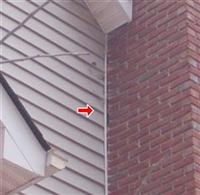 |
 (2) Brick exterior at left side of house (facing front) cracked at corners. Can result in possible
water intrusion behind brick and into framing. Recommend repair person inspect and correct,
sealing as necessary.
(2) Brick exterior at left side of house (facing front) cracked at corners. Can result in possible
water intrusion behind brick and into framing. Recommend repair person inspect and correct,
sealing as necessary.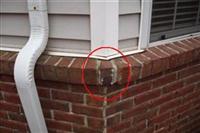 | 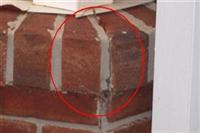 | 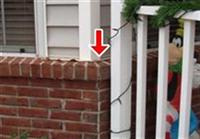 |
 2.2 (1) The wood trim is peeling paint at half round trim of windows. Further deterioration may occur if
not repaired. I recommend sealing and painting as necessary as part of normal maintenance.
2.2 (1) The wood trim is peeling paint at half round trim of windows. Further deterioration may occur if
not repaired. I recommend sealing and painting as necessary as part of normal maintenance. |
 |
 (3) The seal between glass window panes are failing on some windows at rear of house, (back
porch off Kitchen and windows of family room), moisture and fogging evident between panes of
glass. Recommend qualified contractor inspect and repair as necessary.
(3) The seal between glass window panes are failing on some windows at rear of house, (back
porch off Kitchen and windows of family room), moisture and fogging evident between panes of
glass. Recommend qualified contractor inspect and repair as necessary. 2.3 Back porch has plumbing drain pipe clean out where concrete around drain pipe has cracked
and fallen away. Possible water intrusion area into home and foundation, recommend having
repair person inspect, seal and patch as necessary.
2.3 Back porch has plumbing drain pipe clean out where concrete around drain pipe has cracked
and fallen away. Possible water intrusion area into home and foundation, recommend having
repair person inspect, seal and patch as necessary.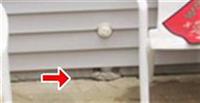 |
 2.4 The sidewalk at the front of home uneven, and can be a tripping hazard. A fall or injury can
occur if not corrected. I recommend repair as desired.
2.4 The sidewalk at the front of home uneven, and can be a tripping hazard. A fall or injury can
occur if not corrected. I recommend repair as desired. |
 2.5 (1) A gap between the soffit and fascia exists which allows insects or bees to enter attic. A
qualified person should repair or replace as needed.
2.5 (1) A gap between the soffit and fascia exists which allows insects or bees to enter attic. A
qualified person should repair or replace as needed.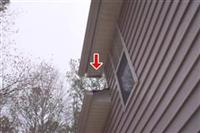 |
 (2) The soffit panel at eave on the rear of home right side (facing front) has small hole behind light
fixture which allows insects or bees to enter attic. This is a small repair. A qualified person
should repair or replace as needed.
(2) The soffit panel at eave on the rear of home right side (facing front) has small hole behind light
fixture which allows insects or bees to enter attic. This is a small repair. A qualified person
should repair or replace as needed.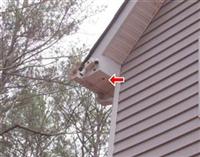 |
 (3) The metal fascia wrap at eave on the right side (facing front) over garage loose. Further
deterioration may occur if not repaired. A qualified person should repair or replace as needed.
(3) The metal fascia wrap at eave on the right side (facing front) over garage loose. Further
deterioration may occur if not repaired. A qualified person should repair or replace as needed.
| Styles & Materials Garage Door Type: One automatic Garage Door Material:
Compressed board Wood |
||||||||||||||||||||||||||||||||||||||||||||||||
 3.3 (1) The garage door at the right side (facing front) shows moisture absorption on composite type
panels and does not close or seal tight at floor also needs weather stripping replaced at
bottom. This is a maintenance issue and is for your information. A qualified contractor should
inspect and repair as needed.
3.3 (1) The garage door at the right side (facing front) shows moisture absorption on composite type
panels and does not close or seal tight at floor also needs weather stripping replaced at
bottom. This is a maintenance issue and is for your information. A qualified contractor should
inspect and repair as needed. (2) The garage door at the right side (facing front) of home has missing weather-stripping at bottom
of door. Further deterioration may occur if not repaired. A qualified person should repair or
replace as needed.
(2) The garage door at the right side (facing front) of home has missing weather-stripping at bottom
of door. Further deterioration may occur if not repaired. A qualified person should repair or
replace as needed.
| Styles & Materials Ceiling Materials: Sheetrock Wall Material: Sheetrock Wallpaper Tile Floor Covering(s): Carpet Tile Wood Interior Doors: Hollow core Window Types: Thermal/Insulated Single-hung Window Manufacturer: UNKNOWN Cabinetry: Wood Countertop:
Laminate |
||||||||||||||||||||||||||||||||||||||||||||||||||||||
 4.0 The Sheetrock on the ceiling has gaps between wall and ceiling junction (cosmetic) in the
Master bath. This damage is considered cosmetic. I recommend prep prime and paint as
needed.
4.0 The Sheetrock on the ceiling has gaps between wall and ceiling junction (cosmetic) in the
Master bath. This damage is considered cosmetic. I recommend prep prime and paint as
needed.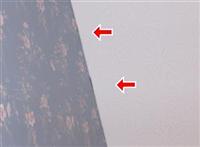 |
 4.1 The sheetrock and carpet on the wall below right side of master bathtub shows wet stains
indicating moisture or intrusion did or still may occur at the master bath. Wall and carpet
appeared dry at time of inspection. A qualified person should inspect and repair or replace
as needed.
4.1 The sheetrock and carpet on the wall below right side of master bathtub shows wet stains
indicating moisture or intrusion did or still may occur at the master bath. Wall and carpet
appeared dry at time of inspection. A qualified person should inspect and repair or replace
as needed.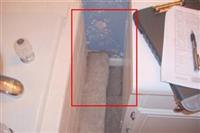 |
 4.2 (1) The wood flooring at the at end of hall downstairs at kitchen entrance is worn and discoloring.
This is a small repair issue for your information. A qualified person should repair or replace as
needed.
4.2 (1) The wood flooring at the at end of hall downstairs at kitchen entrance is worn and discoloring.
This is a small repair issue for your information. A qualified person should repair or replace as
needed.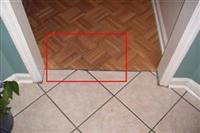 |
 (2) The Carpet has small burn mark at the fireplace hearth extension in Living Room. This is a
cosmetic issue for your information. I recommend repair as desired.
(2) The Carpet has small burn mark at the fireplace hearth extension in Living Room. This is a
cosmetic issue for your information. I recommend repair as desired.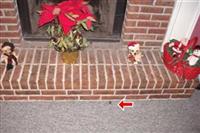 |
 (3) Sub floor is uneven at the entrance of Master Bedroom near entrance of master bath. A
qualified contractor should inspect and repair as needed.
(3) Sub floor is uneven at the entrance of Master Bedroom near entrance of master bath. A
qualified contractor should inspect and repair as needed. (4) The Carpet is loose or baggy and not stretched for a tight installation at the upstairs hallway
and Bedroom over garage. This is a cosmetic issue for your information. I recommend repair as
desired.
(4) The Carpet is loose or baggy and not stretched for a tight installation at the upstairs hallway
and Bedroom over garage. This is a cosmetic issue for your information. I recommend repair as
desired.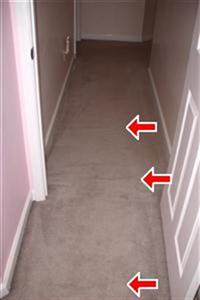 |
 4.6 (1) Several windows cloudy and moisture is evident (lost seal) downstairs backside of house in
Family room and off kitchen. In order to correct the cloudy appearance of glass, a replacement
of glass pane or the unit will be necessary. A qualified person should repair or replace as needed.
4.6 (1) Several windows cloudy and moisture is evident (lost seal) downstairs backside of house in
Family room and off kitchen. In order to correct the cloudy appearance of glass, a replacement
of glass pane or the unit will be necessary. A qualified person should repair or replace as needed. (2) One window blind on leftmost window in the Master Bedroom is inoperable and will not lift with
cord. This is a cosmetic issue for your information. I recommend repair as desired.
(2) One window blind on leftmost window in the Master Bedroom is inoperable and will not lift with
cord. This is a cosmetic issue for your information. I recommend repair as desired.
| Styles & Materials Foundation: Poured concrete Floor Structure: 2 X 8 Wood joists Slab Wall Structure: 2 X 4 Wood Ceiling Structure: 2X8 Roof Structure: 2 X 6 Rafters Plywood Roof-Type: Gable Shed Method used to observe attic: Walked Attic info:
Attic access Pull Down stairs Storage Light in attic |
||||||||||||||||||||||||||||||||||||||||||
 5.4 Water stain signs are on plywood resulting from a roof leak found in several spots in attic. The
roof covering needs repair or replace in this area. A qualified roofing contractor should inspect
these areas further and any other problem areas and repair or replace as necessary.
5.4 Water stain signs are on plywood resulting from a roof leak found in several spots in attic. The
roof covering needs repair or replace in this area. A qualified roofing contractor should inspect
these areas further and any other problem areas and repair or replace as necessary.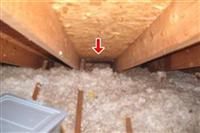 | 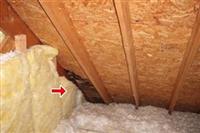 | 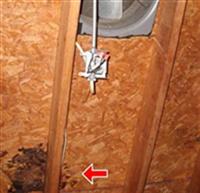 |
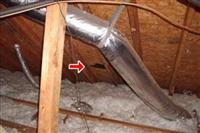 |
| Styles & Materials Water Source: Public Water Filters: None Plumbing Water Supply (into home): Copper Plumbing Water Distribution (inside home): POLY Washer Drain Size: 2" Diameter Plumbing Waste: PVC Water Heater Power Source: Gas (quick recovery) Water Heater Capacity:
40 Gallon (1-2 people) |
||||||||||||||||||||||||||||||||||||||||||
 6.0 Water heater emergency drain pan, drain line not connected and spills into garage, possible
water hazard. Recommend repairman evaluate and connect drain line to outside of house.
6.0 Water heater emergency drain pan, drain line not connected and spills into garage, possible
water hazard. Recommend repairman evaluate and connect drain line to outside of house.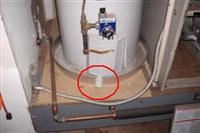 |
 6.1 (1) The shower head control knob leaks at the master bath upstairs bath. Repairs are needed. A
qualified licensed plumber should repair or correct as needed.
6.1 (1) The shower head control knob leaks at the master bath upstairs bath. Repairs are needed. A
qualified licensed plumber should repair or correct as needed. (2) The hose bib missing vacuum break at the rear of home right side (facing front) near outside
A/C units. This is not considered up to today's standard as it can cause cross contamination of
water supply in home. Recommend installing vacuum break on all hose bibs.
(2) The hose bib missing vacuum break at the rear of home right side (facing front) near outside
A/C units. This is not considered up to today's standard as it can cause cross contamination of
water supply in home. Recommend installing vacuum break on all hose bibs. (3) Polybutylene plastic plumbing supply lines (PB) are installed in the subject house.
Polybutylene has been used in this area for many years, but has had a higher than normal
failure rate, and is no longer being widely used. Copper and Brass fittings used in later years
have apparently reduced the failure rate. This subject house has copper fittings. For further
details contact the Consumer Plumbing Recovery center at 1-800-392-7591 or the web at
http://www.pbpipe.com
(3) Polybutylene plastic plumbing supply lines (PB) are installed in the subject house.
Polybutylene has been used in this area for many years, but has had a higher than normal
failure rate, and is no longer being widely used. Copper and Brass fittings used in later years
have apparently reduced the failure rate. This subject house has copper fittings. For further
details contact the Consumer Plumbing Recovery center at 1-800-392-7591 or the web at
http://www.pbpipe.com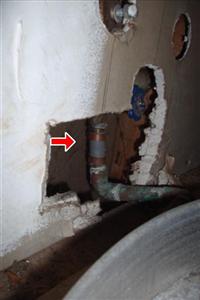 |
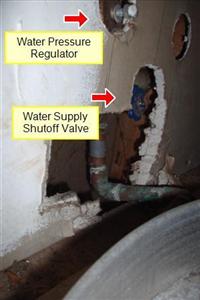 |
| Styles & Materials Electrical Service Conductors: Below ground Aluminum 220 volts Panel capacity: Adequate Panel Type: Circuit breakers Electric Panel Manufacturer: Unknown Branch wire 15 and 20 AMP: Copper Wiring Methods:
Romex |
||||||||||||||||||||||||||||||||||||||||||||||||||||||||||||
 7.3 (1) Attic fan splice box needs a cover-plate above the heater blower unit in attic. This is a safety
issue that needs to be corrected Exposed wiring is considered unsafe until repaired. I
recommend a qualified licensed electrician evaluate and repair and replace as necessary.
7.3 (1) Attic fan splice box needs a cover-plate above the heater blower unit in attic. This is a safety
issue that needs to be corrected Exposed wiring is considered unsafe until repaired. I
recommend a qualified licensed electrician evaluate and repair and replace as necessary.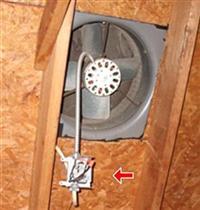 |
 (2) Wiring to heater blower unit in attic has metal conduit which terminates abruptly at a turn in
the electrical wire and exposed sharp edges are susceptible to cutting wire sheathing. This
is a safety and fire hazard issue that needs to be corrected Exposed wiring is considered
unsafe until repaired. I recommend a qualified licensed electrician evaluate and repair and
replace as necessary.
(2) Wiring to heater blower unit in attic has metal conduit which terminates abruptly at a turn in
the electrical wire and exposed sharp edges are susceptible to cutting wire sheathing. This
is a safety and fire hazard issue that needs to be corrected Exposed wiring is considered
unsafe until repaired. I recommend a qualified licensed electrician evaluate and repair and
replace as necessary.
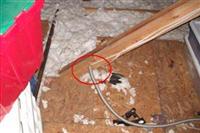 | 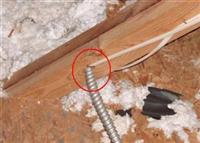 |
 (3) The light fixture does not work bulbs missing (try bulb first) at back of house outside rear corner
fixture. This is for your information. I recommend repair as needed.
(3) The light fixture does not work bulbs missing (try bulb first) at back of house outside rear corner
fixture. This is for your information. I recommend repair as needed.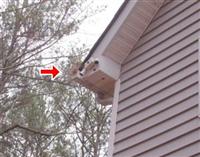 |
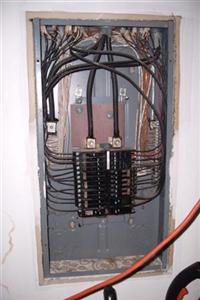 |
| Styles & Materials Heat Type: Forced Air Energy Source: Natural gas Number of Heat Systems (excluding wood): Two Ductwork: Insulated Filter Type: Disposable Extra Info : Honeywell Enviracaire Elite air purifier on each system Filter Size: (Two filters) 16x25 Extra Info : Honeywell Enviracaire Elite air filter Types of Fireplaces: Gas/LP Log starter Operable Fireplaces: One Cooling Equipment Type: Air conditioner unit Cooling Equipment Energy Source: Electricity Central Air Manufacturer: INT. COMFORT RUDD Number of AC Only Units:
Two Extra Info : 2 Ton and 2.5 Ton units |
||||||||||||||||||||||||||||||||||||||||||||||||||||||||||||||||||||||||||||||
 8.5 (1) The chimney liner was partially visible and appears good except for creosote dust that may
conceal a hairline crack until cleaned and inspected by a licensed chimney sweep. For a
detailed inspection of liner, I recommend a qualified chimney sweep inspect for safety.
8.5 (1) The chimney liner was partially visible and appears good except for creosote dust that may
conceal a hairline crack until cleaned and inspected by a licensed chimney sweep. For a
detailed inspection of liner, I recommend a qualified chimney sweep inspect for safety. (2) The chimney liner was not thoroughly inspected by our company. I recommend a qualified
chimney sweep inspect for safety.
(2) The chimney liner was not thoroughly inspected by our company. I recommend a qualified
chimney sweep inspect for safety. (3) Metal rain cap on chimney crown/cap is rusting. Recommend qualified repair contractor to
inspect, remove rust and paint to prevent further corrosion.
(3) Metal rain cap on chimney crown/cap is rusting. Recommend qualified repair contractor to
inspect, remove rust and paint to prevent further corrosion.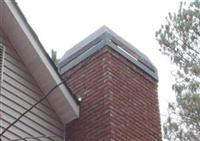 |
 8.8 (1) The A/C was not tested for proper operation due to the outside air temperature is 65 degrees
or less. We did not inspect this unit(s). Recommend having unit inspected when
temperatures increase to proper levels testing unit to verify operation by qualified HVAC
technician
8.8 (1) The A/C was not tested for proper operation due to the outside air temperature is 65 degrees
or less. We did not inspect this unit(s). Recommend having unit inspected when
temperatures increase to proper levels testing unit to verify operation by qualified HVAC
technician (2)
The A/C low pressure line entering evaporating coil requires insulation to prevent water
condensation from forming and dripping into blower housing causing possible electrical failure or
corrosion damage to heater or blower unit . Recommend having licensed heating and air contractor
to evaluate and repair/replace insulation as necessary.
(2)
The A/C low pressure line entering evaporating coil requires insulation to prevent water
condensation from forming and dripping into blower housing causing possible electrical failure or
corrosion damage to heater or blower unit . Recommend having licensed heating and air contractor
to evaluate and repair/replace insulation as necessary.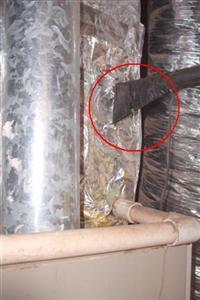 | 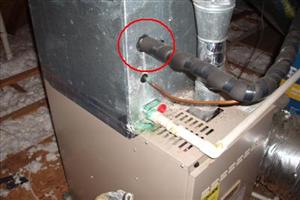 |
 (3) The A/C low pressure line requires insulation to prevent water condensation from forming
and dripping into attic insulation, house structure or wall cavity causing possible water
damage or unhealthy mold conditions . Recommend having licensed heating and air
contractor to evaluate and repair/replace insulation as necessary.
(3) The A/C low pressure line requires insulation to prevent water condensation from forming
and dripping into attic insulation, house structure or wall cavity causing possible water
damage or unhealthy mold conditions . Recommend having licensed heating and air
contractor to evaluate and repair/replace insulation as necessary.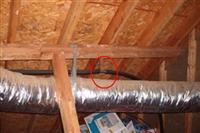 |
| Styles & Materials Attic Insulation: Blown Fiberglass R-19 or better Ventilation: Gable vents Soffit Vents Thermostatically controlled fan Exhaust Fans: Fan only Dryer Power Source: 220 Electric Dryer Vent:
Unknown |
||||||||||||||||||||||||||||||||||||
 9.2 The bathroom exhaust fan has vent pipe which terminates in attic at the master bath and
upstairs bath. Vent pipes that terminate in attic space can sometimes cause moisture that can
lead to mold or cause condensation. A qualified person should repair or replace as needed.
9.2 The bathroom exhaust fan has vent pipe which terminates in attic at the master bath and
upstairs bath. Vent pipes that terminate in attic space can sometimes cause moisture that can
lead to mold or cause condensation. A qualified person should repair or replace as needed.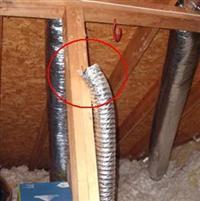 | 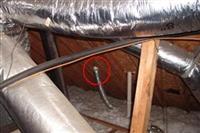 | 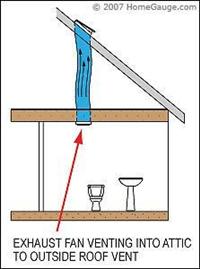 |
| Styles & Materials Disposer Brand: UNKNOWN Exhaust/Range hood: RE-CIRCULATE Range/Oven:
UNKNOWN |
||||||||||||||||||||||||||||||||||||
|
TurningStone Home Inspection, LLC PO Box 2141 |
ATTENTION: This inspection report is incomplete without reading the information included herein at these links/attachments. Note If you received a printed version of this page and did not receive a copy of the report through the internet please contact your inspector for a printed copy of the attachments
Weather Forecast Inspection Day